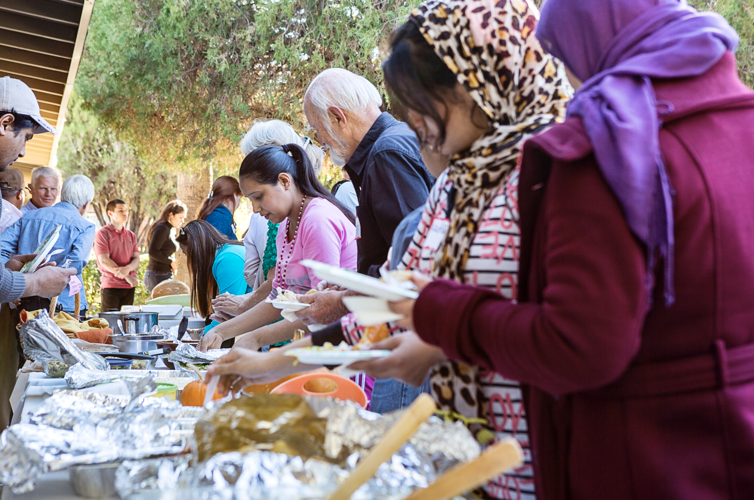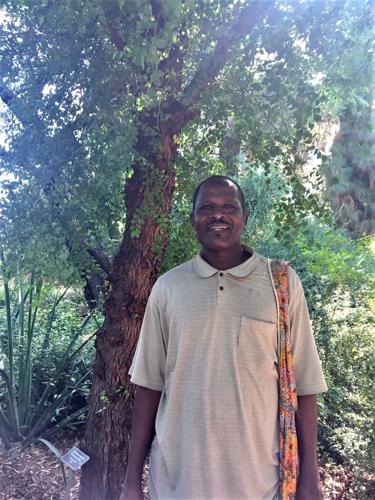More than 8,000 miles from his native Darfur, Ibrahim Abaker breaks into a big, broad smile.
He has plucked a tiny brown fruit, smaller than a penny, from a tree at the Tucson Botanical Gardens and popped the jujube into his mouth.
“In Sudan, we eat them off the tree,” he says. “We had a tree in my yard when I was growing up.”
Americans don’t know much about jujube fruits, but in cultures around the world where the tree grows, the little fruits are prized. A bit crunchy, the dry-textured fruit with a tiny pit tastes a little like apple, with slight menthol aftertaste. But for Abaker, it’s a sudden reminder of the home he left behind.
He and several other volunteers from the nonprofit group Iskashitaa were harvesting a variety of fruits and nuts on the beautiful grounds of the botanical gardens, 2150 N. Alvernon Way.
Led by Iskashitaa intern Nolan Rose, the group of 10 harvested figs, carob, jojoba nuts and pomegranates in addition to the jujubes.
Iskashitaa, pronounced “Is-kah-SHEE-tah,” is a Somali word that means “working cooperatively together,” says the organization’s founder and director, Barbara Eiswerth. Since 2003, the organization has helped thousands of United Nations refugees, members of 32 ethnic groups, resettle in Tucson and integrate into their new communities. The organization aims “to get refugees integrated and establishing their own networks through the common denominator of food,” says Eiswerth.
“Refugees face two issues,” she says. “One is social isolation, and the other is the lack of fresh local produce that one in four people in Pima County suffers. Through Iskashitaa, our clients get comradery, cultural orientation, and have a chance to practice their English. We don’t give hand-outs. We give a hand up.”
One part of Iskashitaa’s mission is to recover fresh, local food that would otherwise go to waste, she says. To that end, crews visit various parts of the city twice a week to harvest ripe produce from backyards, public property and participating organizations, such as the botanical gardens. They harvest at Mission Garden at San Augustin Mission, the University of Arizona, Felicia’s Farm and Tohono Chul as well.
Rather than letting all the citrus on those backyard trees go to waste, Eiswerth says, a homeowner — or a homeowners’ association — can make a small donation and the volunteers will harvest the ripe fruit. “We’ll share the harvest with the homeowner if they want us to,” she says. Otherwise, about half of all food harvested goes to refugee families, another portion goes to food banks, both urban and rural; soup kitchens; and more. A tiny remainder goes to Iskashitaa’s own classes, where refugees can learn to cook with American ingredients.
“Whatever we lose, we try to feed to pigs, chickens, goats or tortoises,” Eiswerth says. “If we can’t do that, we compost it and give the compost to the refugees, who have community gardens or gardens in their own yards.”
Iskashitaa also hosts monthly luncheons, open to the public.
All this outreach poses an incredible workload for Iskashitaa’s tiny staff — just two full-time employees, and two part-time people. “We’re extremely lean,” Eiswerth says. “We need community support.”
Pan-roasted chicken with figs, olives and lemon
Makes about 4 servings
Gluten-free
Americans don’t often cook chicken with fruit, but in Middle Eastern and African countries, where figs, olives and lemon are all local ingredients, chicken pairs beautifully with figs. The silky pan sauce begs for rice or couscous to soak it up. Zest the lemon before you juice it.
Ingredients
8 bone-in, skin-on chicken thighs
1 teaspoon salt
ƒ teaspoon pepper
2 tablespoons olive oil
1 large sweet onion, halved and cut into half moons
12 fresh or dried figs, stemmed
1 cup green olives, such as picholine, or kalamata olives, pitted and halved
Zest from 1 lemon, cut into «-inch wide strips
1 cup chicken stock or dry white wine
Juice of 1 lemon
3 to 4 sprigs fresh thyme, or 2 teaspoons dried thyme
1 bay leaf
Preparation
Preheat the oven to 400 degrees. Season the chicken thighs on all sides with the salt and pepper. Heat the olive oil in a large heavy skillet over medium-high heat. When the oil is hot, place four or five chicken thighs skin side down in the skillet. Cook for 10 minutes without moving the thighs, until the skin is deep golden brown. Turn and cook for 3 minutes longer. Remove chicken thighs to a plate; repeat with remaining thighs.
With the skillet still over medium-high heat, add the onion half-moons. Cook, stirring, until the onion is limp and translucent, about 10 minutes. Add the olives and lemon zest to the onions, then nestle the chicken thighs atop the mixture.
Pour the chicken stock or wine and lemon juice over the chicken. Tuck the thyme sprigs and bay leaf into the skillet. Cover the skillet with foil and place in the oven.
Bake for 40 to 45 minutes, or until the juices run clear when a thigh is poked with a fork. Serve atop couscous or rice, spooning the pan juices over each serving.
Next week: Golden Rule Dairy, a licensed grade A Jersey dairy in Elfrida, is one of a handful of raw milk dairies in the state. What makes Jersey milk so special?





